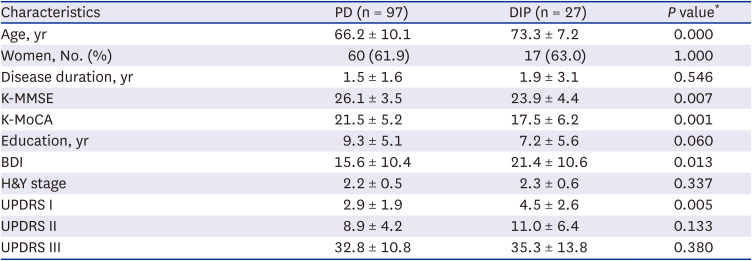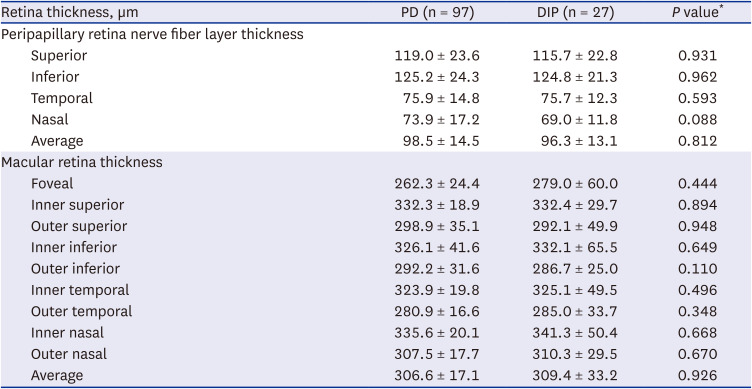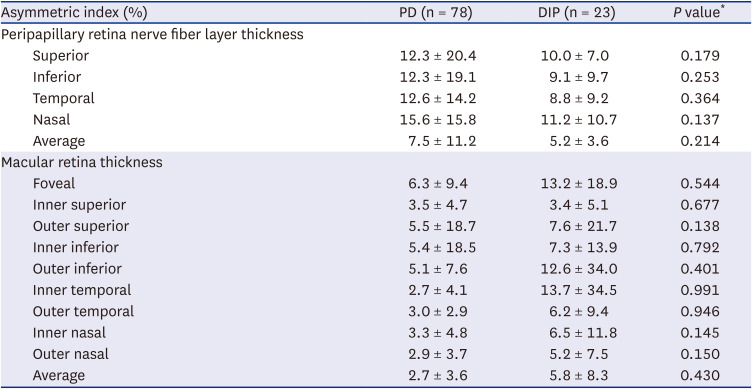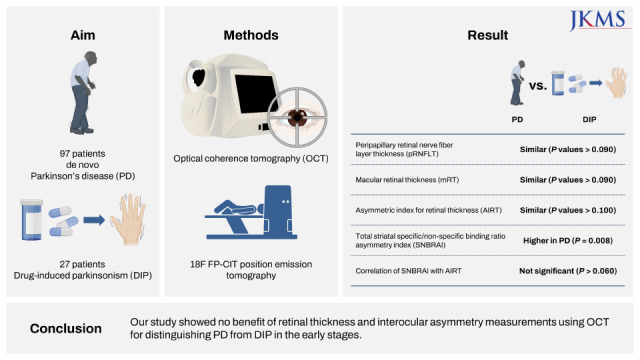1. Shin HW, Chung SJ. Drug-induced parkinsonism. J Clin Neurol. 2012; 8(1):15–21. PMID:
22523509.
2. Yoo HS, Bak Y, Chung SJ, Lee Y, Ye BS, Sohn YH, et al. Impaired functional connectivity of sensorimotor network predicts recovery in drug-induced parkinsonism. Parkinsonism Relat Disord. 2020; 74:16–21. PMID:
32283491.
3. Byun JH, Cho H, Kim YJ, Kim JS, Baik JS, Jang S, et al. Trends in the prevalence of drug-induced parkinsonism in Korea. Yonsei Med J. 2019; 60(8):760–767. PMID:
31347331.
4. Sung YH, Noh Y, Lee J, Kim EY. Drug-induced parkinsonism versus idiopathic Parkinson disease: utility of nigrosome 1 with 3-T imaging. Radiology. 2016; 279(3):849–858. PMID:
26690908.
5. Kim JS, Ryu DW, Oh JH, Lee YH, Park SJ, Jeon K, et al. Cardiovascular autonomic dysfunction in patients with drug-induced parkinsonism. J Clin Neurol. 2017; 13(1):15–20. PMID:
27730767.
6. Koh SB, Jo YH, Kim BJ, Park MK, Park KW, Lee DH. Clinical characteristics of drug-induced parkinsonism. J Korean Geriatr Soc. 2001; 5(1):43–49.
7. Lee SH, Kim HK, Lee YG, Lyoo CH, Ahn SJ, Lee MS. Clinical features indicating nigrostriatal dopaminergic degeneration in drug-induced parkinsonism. J Mov Disord. 2017; 10(1):35–39. PMID:
28122428.
8. Kim JM, Kim YK, Kim SE, Jeon BS. Clinical usefulness of dopamine transporter imaging. Nucl Med Mol Imaging. 2007; 41(2):152–157.
9. Baek SU, Kang SY, Kwon S, Park IW, Suh W. Motor asymmetry and interocular retinal thickness in Parkinson’s disease. J Korean Med Sci. 2021; 36(6):e50. PMID:
33559408.
10. Lee JY, Martin-Bastida A, Murueta-Goyena A, Gabilondo I, Cuenca N, Piccini P, et al. Multimodal brain and retinal imaging of dopaminergic degeneration in Parkinson disease. Nat Rev Neurol. 2022; 18(4):203–220. PMID:
35177849.
11. Kaur M, Saxena R, Singh D, Behari M, Sharma P, Menon V. Correlation between structural and functional retinal changes in Parkinson disease. J Neuroophthalmol. 2015; 35(3):254–258. PMID:
25807477.
12. Lee JY, Kim JM, Ahn J, Kim HJ, Jeon BS, Kim TW. Retinal nerve fiber layer thickness and visual hallucinations in Parkinson’s disease. Mov Disord. 2014; 29(1):61–67. PMID:
23775932.
13. Aaker GD, Myung JS, Ehrlich JR, Mohammed M, Henchcliffe C, Kiss S. Detection of retinal changes in Parkinson’s disease with spectral-domain optical coherence tomography. Clin Ophthalmol. 2010; 4:1427–1432. PMID:
21188154.
14. Altintaş O, Işeri P, Ozkan B, Cağlar Y. Correlation between retinal morphological and functional findings and clinical severity in Parkinson’s disease. Doc Ophthalmol. 2008; 116(2):137–146. PMID:
17962989.
15. Jiménez B, Ascaso FJ, Cristóbal JA, López del Val J. Development of a prediction formula of Parkinson disease severity by optical coherence tomography. Mov Disord. 2014; 29(1):68–74. PMID:
24458320.
16. Pieters LE, Bakker PR, van Harten PN. Asymmetric drug-induced parkinsonism and psychopathology: a prospective naturalistic study in long-stay psychiatric patients. Front Psychiatry. 2018; 9:18. PMID:
29459835.
17. Hughes AJ, Ben-Shlomo Y, Daniel SE, Lees AJ. What features improve the accuracy of clinical diagnosis in Parkinson’s disease: a clinicopathologic study. Neurology. 1992; 42(6):1142–1146. PMID:
1603339.
18. Jiménez-Jiménez FJ, Ortí-Pareja M, Ayuso-Peralta L, Gasalla T, Cabrera-Valdivia F, Vaquero A, et al. Drug-induced parkinsonism in a movement disorders unit: a four-year survey. Parkinsonism Relat Disord. 1996; 2(3):145–149. PMID:
18591033.
19. Lee E, Lee JE, Yoo K, Hong JY, Oh J, Sunwoo MK, et al. Neural correlates of progressive reduction of bradykinesia in de novo Parkinson’s disease. Parkinsonism Relat Disord. 2014; 20(12):1376–1381. PMID:
25304859.
20. Oh M, Kim JS, Kim JY, Shin KH, Park SH, Kim HO, et al. Subregional patterns of preferential striatal dopamine transporter loss differ in Parkinson disease, progressive supranuclear palsy, and multiple-system atrophy. J Nucl Med. 2012; 53(3):399–406. PMID:
22323779.
21. Mawlawi O, Martinez D, Slifstein M, Broft A, Chatterjee R, Hwang DR, et al. Imaging human mesolimbic dopamine transmission with positron emission tomography: I. Accuracy and precision of D
2 receptor parameter measurements in ventral striatum. J Cereb Blood Flow Metab. 2001; 21(9):1034–1057. PMID:
11524609.
22. Oh JS, Oh M, Chung SJ, Kim JS. Cerebellum-specific 18F-FDG PET analysis for the detection of subregional glucose metabolism changes in spinocerebellar ataxia. Neuroreport. 2014; 25(15):1198–1202. PMID:
25144395.
23. Innis RB, Cunningham VJ, Delforge J, Fujita M, Gjedde A, Gunn RN, et al. Consensus nomenclature for in vivo imaging of reversibly binding radioligands. J Cereb Blood Flow Metab. 2007; 27(9):1533–1539. PMID:
17519979.
24. Zijlmans J, Evans A, Fontes F, Katzenschlager R, Gacinovic S, Lees AJ, et al. [
123I] FP-CIT SPECT study in vascular parkinsonism and Parkinson’s disease. Mov Disord. 2007; 22(9):1278–1285. PMID:
17486613.
25. Mello LG, Bissoli LB, Saraiva FP, Maia RP, Monteiro ML. retinal layers and choroid measurements in Parkinson’s disease with or without pramipexole treatment. Mov Disord. 2020; 35(12):2357–2359. PMID:
32901990.
26. Kline RB. Principles and Practice of Structural Equation Modeling. 3rd ed. New York, NY, USA: Guilford Press;2011.
27. Zhou WC, Tao JX, Li J. Optical coherence tomography measurements as potential imaging biomarkers for Parkinson’s disease: a systematic review and meta-analysis. Eur J Neurol. 2021; 28(3):763–774. PMID:
33107159.
28. Alkabie S, Lange A, Manogaran P, Stoessl AJ, Costello F, Barton JJ. Optical coherence tomography of patients with Parkinson’s disease and progressive supranuclear palsy. Clin Neurol Neurosurg. 2020; 189:105635. PMID:
31855622.
29. Tsironi EE, Dastiridou A, Katsanos A, Dardiotis E, Veliki S, Patramani G, et al. Perimetric and retinal nerve fiber layer findings in patients with Parkinson’s disease. BMC Ophthalmol. 2012; 12(1):54. PMID:
23031247.
30. Pillai JA, Bermel R, Bonner-Jackson A, Rae-Grant A, Fernandez H, Bena J, et al. Retinal nerve fiber layer thinning in Alzheimer’s disease: a case-control study in comparison to normal aging, Parkinson’s disease, and non-Alzheimer’s dementia. Am J Alzheimers Dis Other Demen. 2016; 31(5):430–436. PMID:
26888864.
31. Clémence-Fau M, Schwan R, Angioi-Duprez K, Laprévote V, Schwitzer T. Retinal structural changes in mood disorders: the optical coherence tomography to better understand physiopathology? Prog Neuropsychopharmacol Biol Psychiatry. 2021; 108:110080. PMID:
32827610.
32. Jerotic S, Ignjatovic Z, Silverstein SM, Maric NP. Structural imaging of the retina in psychosis spectrum disorders: current status and perspectives. Curr Opin Psychiatry. 2020; 33(5):476–483. PMID:
32639357.
33. Faure C, Audo I, Zeitz C, Letessier JB, Robert MP. Aripiprazole-induced chorioretinopathy: multimodal imaging and electrophysiological features. Doc Ophthalmol. 2015; 131(1):35–41. PMID:
25791769.
34. Fornaro P, Calabria G, Corallo G, Picotti GB. Pathogenesis of degenerative retinopathies induced by thioridazine and other antipsychotics: a dopamine hypothesis. Doc Ophthalmol. 2002; 105(1):41–49. PMID:
12152801.
35. Zhuo C, Ji F, Xiao B, Lin X, Chen C, Jiang D, et al. Antipsychotic agent-induced deterioration of the visual system in first-episode untreated patients with schizophrenia maybe self-limited: findings from a secondary small sample follow-up study based on a pilot follow-up study. Psychiatry Res. 2020; 286:112906. PMID:
32151847.
36. Shrier EM, Adam CR, Spund B, Glazman S, Bodis-Wollner I. Interocular asymmetry of foveal thickness in Parkinson disease. J Ophthalmol. 2012; 2012:728457. PMID:
22900149.
37. Chua J, Tham YC, Tan B, Devarajan K, Schwarzhans F, Gan A, et al. Age-related changes of individual macular retinal layers among Asians. Sci Rep. 2019; 9(1):20352. PMID:
31889143.







 PDF
PDF Citation
Citation Print
Print




 XML Download
XML Download